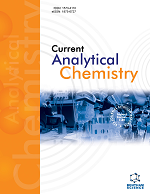- Home
- A-Z Publications
- Current Analytical Chemistry
- Previous Issues
- Volume 20, Issue 9, 2024
Current Analytical Chemistry - Volume 20, Issue 9, 2024
Volume 20, Issue 9, 2024
-
-
Studies on Quantitative Determination of Polyphenols in Seven Harvesting Times of Salvia deserta Schang Leaves and its Stability Evaluation
More LessAuthors: Linyang Wang, Ainiwaer Aikemu, Liwa Wang and Shuge TianIntroduction: Leaves of Salvia deserta Schang at seven harvesting times in the same year were collected as the materials. Method: The polyphenols were determined by the Folin–Ciocaileu method and High-Performance Liquid Chromatography (HPLC) to compare the quality of samples. The stability of polyphenols was studied under different conditions (light, temperature, pH, common additives). Results: The results showed t Read More
-
-
-
Deep Learning-enhanced Hyperspectral Imaging for the Rapid Identification and Classification of Foodborne Pathogens
More LessBy Hanjing GeBackground: Bacterial cellulose (BC) is a versatile biomaterial with numerous applications, and the identification of bacterial strains that produce it is of great importance. This study explores the effectiveness of a Stacked Autoencoder (SAE)-based deep learning method for the classification of bacterial cellulose-producing bacteria. Objective: The primary objective of this research is to assess the potential of SAE-based classifica Read More
-
-
-
Analysis of Seven Terpenoids by HS-SPME Coupled with GC-MS for the Identification and Classification of Different Teas
More LessAuthors: Yangzhou Xie, Yi Yang, Yu Tian, Zhimin Liu, Zhigang Xu, Wei Jiang, Zhihua Liu and Xiaoxi SiBackground: Terpenoids are essential aroma substances in teas, and their concentration brings various characteristics to different teas. Therefore, developing a simple and stable method is necessary for distinguishing tea categories. Objective: In previous studies, more attention was paid to non-chiral isomers of terpenes due to the challenges of separating chiral isomers. So, this paper aims to present a method for effectivel Read More
-
-
-
A Typology and Lead Isotope and Cultural Exchange Study on Bronze Knives from Shuangyuan Cemetery, Chengdu City, Southwest China
More LessAuthors: Xiaoting Wang, Yingdong Yang, Tianyou Wang and Wugan LuoBackground: Bronze knives, which have been excavated in large quantities and acquired hierarchical significance, are essential artifacts in Shu State in Southwest China. Building upon previous typological analyses of bronze knives, it is hypothesized that Shu culture may have imported foreign-style bronze knives. However, further demonstration of the provenance of metal materials, the types of knives, and the cultural Read More
-
-
-
A New Modified Carbon Paste Electrode for Selective Determination of Chromium(III) in Pharmaceutical Drugs and Food Samples
More LessAuthors: Safa S. EL-Sanafery, Khaled M. Hussein, Ashraf A. Abbas, M. M. Omar and Gehad G. MohamedBackground and Objective: This study presents a novel potentiometric method for the precise, accurate, selective, and rapid determination of Cr(III) ion concentration in different samples. Methods: A new ionophore, namely macrocyclic tetramide ionophore (MCTA), was synthesized through an inexpensive and straightforward approach, yielding a high-quality product. The (MCTA) ionophore was utilized as the active c Read More
-
-
-
Layer-by-layer Fabrication of Gold Nanoparticles/Polyaniline Modified Gold Electrodes for Direct Non-enzymatic Oxidation of Glucose
More LessAuthors: Waleed A. El-Said, Ahmad Alsulmi and Wael AlshitariBackground: Non-enzymatic direct glucose biofuel cell is a promising technology to harness sustainable renewable energy. Furthermore, monitoring glucose levels is essential for human lives with age. Thus, there is an increasing need to develop highly efficient and stable modified electrodes. Methods: This study reported the manufacture of gold nanoparticles/polyaniline/modified gold electrodes (Au NPs/PANI/Au electrode) ba Read More
-
-
-
Development and Validation of 1H Nuclear Magnetic Resonance Quantitative Method for Efavirenz API Quality Control
More LessBackground: The pharmaceutical industry is constantly looking for a better way to ensure and improve its products' safety, quality, and effectiveness. Since there are many attributes of the drug substance and excipients that could potentially affect the Critical Quality Attributes (CQAs) of the intermediates and the final product, the evaluation of the raw material's physicochemical characteristics is crucial as they Read More
-
-
-
Study on 13C MultiCP/MAS ssNMR Analysis of Tobacco Pectin
More LessAuthors: Xin Ye, Zhenyu Xu, Da Xu, Jibao Cai, Shuiping Dai, Yuting Luo, Lei Guo, Ying Wang, Jiakun Su and Jun YangBackground: As one of the most important economic crops, tobacco products have a long history and dominate the development of the world economy. Pectin, as a complex colloidal substance widely present in plant cell walls, its content is an important factor affecting the safety of tobacco smoking. Objective: This study aimed to analyze the content and structure of pectin in tobacco samples. Methods: In this study, Read More
-
Volumes & issues
-
Volume 21 (2025)
-
Volume 20 (2024)
-
Volume 19 (2023)
-
Volume 18 (2022)
-
Volume 17 (2021)
-
Volume 16 (2020)
-
Volume 15 (2019)
-
Volume 14 (2018)
-
Volume 13 (2017)
-
Volume 12 (2016)
-
Volume 11 (2015)
-
Volume 10 (2014)
-
Volume 9 (2013)
-
Volume 8 (2012)
-
Volume 7 (2011)
-
Volume 6 (2010)
-
Volume 5 (2009)
-
Volume 4 (2008)
-
Volume 3 (2007)
-
Volume 2 (2006)
-
Volume 1 (2005)
Most Read This Month
Article
content/journals/cac
Journal
10
5
false
en


